Mountain birds are fascinating creatures that have adapted to survive in the harsh, high-altitude environments found in mountainous regions.
These birds come in a variety of shapes, sizes, and colors and are known for their unique features, including long, sharp beaks, strong wings, and highly developed eyesight.
Many of these birds are endemic to specific mountain ranges and are rarely found outside of their local habitats. However, some species are highly migratory, traveling across vast distances to breed, feed, and survive.
In this article, we will explore some of the most magnificent mountain birds and learn about their behavior, characteristics, and habitat.
1. Golden Eagle
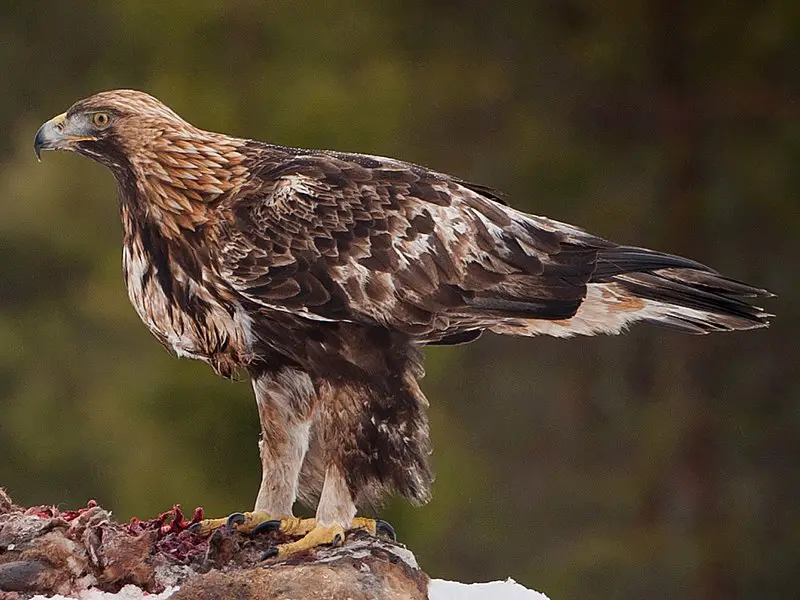
The Golden Eagle is an iconic bird of prey found throughout the northern hemisphere. It is a large, powerful raptor with dark brown feathers and lighter golden-brown plumage on its nape.
Immature eagles have white patches around their beaks, tails and wings which they lose as they mature.
Its diet consists mostly of small mammals such as rabbits, hares and marmots but can also include birds or reptiles depending on where it lives.
These majestic creatures are known for their remarkable strength in flight; using thermal updrafts to soar high into the sky searching for food or simply enjoying the view below them.
They are often seen soaring alone over open expanses looking out for potential threats from other predators like wolves or foxes that may encroach upon their territory.
Scientific classification:
| Kingdom | Animalia |
| Phylum | Chordata |
| Class | Aves |
| Order | Accipitriformes |
| Family | Accipitridae |
| Genus | Aquila |
| Species | A. chrysaetos |
Also Featured In: Most Common Birds in China, Native Birds of Kazakhstan
2. Mountain Bluebird
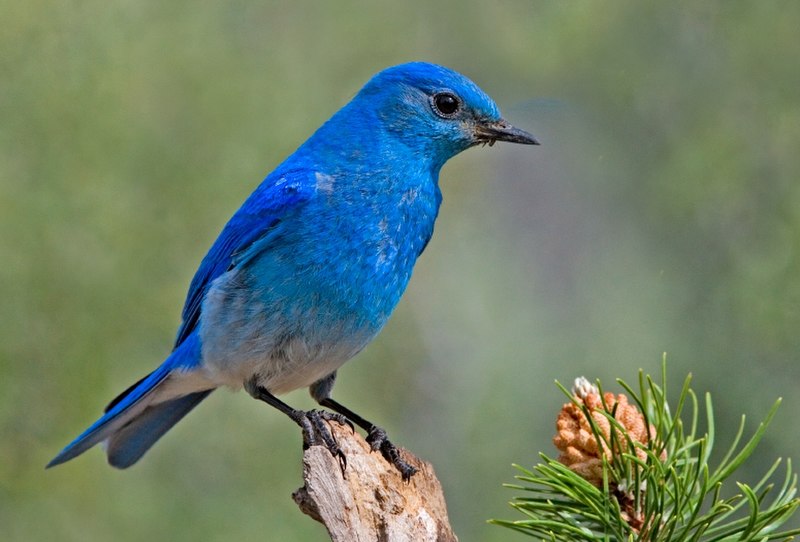
The Mountain Bluebird is a beautiful sight to behold. It has bright turquoise-blue wings and tail, with a light underbelly, grey crown and breast, black eyes and thin bills.
During the fall season its plumage changes slightly – females have duller blue wings and tail, as well as a grey throat and back.
As they migrate across western North America during springtime these birds can be found in mountainous districts where they feed on insects such as grasshoppers or crickets collected from meadows or fields of grain.
They also enjoy eating berries when available. Through their stunning colours this species adds vibrancy to any landscape it traverses through – truly an incredible creature of nature.
Scientific classification:
| Kingdom | Animalia |
| Phylum | Chordata |
| Class | Aves |
| Order | Passeriformes |
| Family | Turdidae |
| Genus | Sialia |
| Species | S. currucoides |
Also Featured In: Most Common United States Birds, Blue Birds You’ll Found around Us
3. Peregrine Falcon
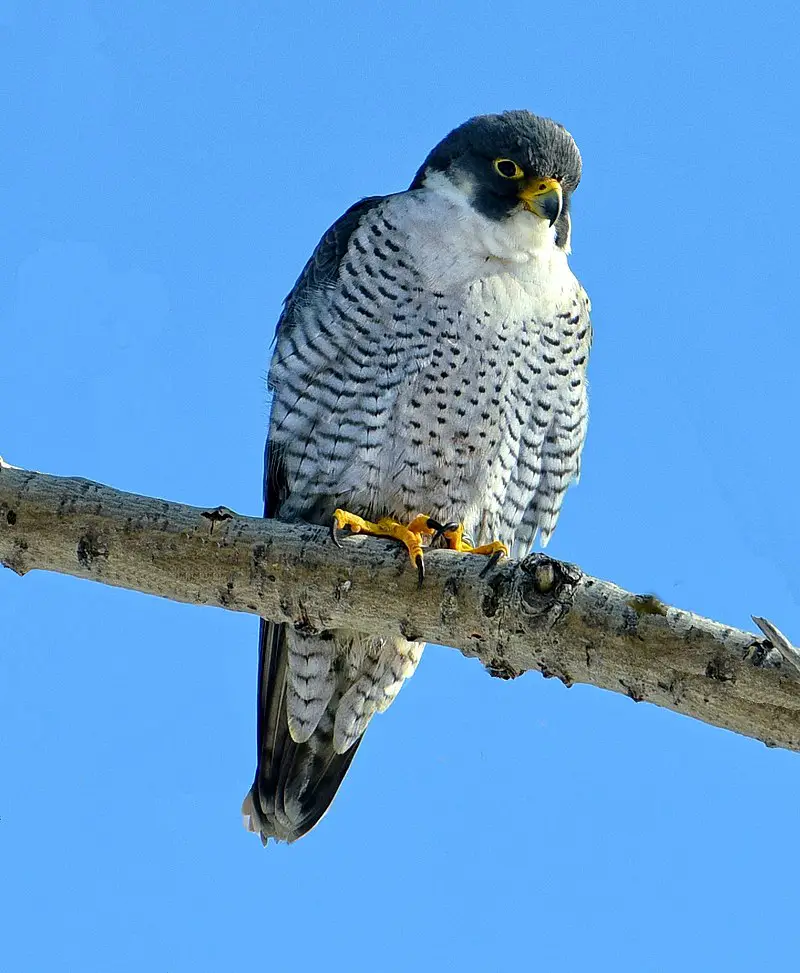
The Peregrine Falcon is a majestic bird of prey belonging to the family Falconidae. It has a blue-grey back, barred white underparts and black head making it easily recognizable.
This intelligent raptor is known for its incredible speed reaching over 320 km/h (200 mph) during hunting dives – one of the fastest animals in existence.
The peregrine falcon can be found around the world from Arctic tundra to tropical rainforests thriving with humans or in high alpine mountains far away from civilization.
With their beauty, power and adaptability they are an impressive species that have earned respect among many cultures throughout history as symbols of strength and endurance.
Scientific classification:
| Kingdom | Animalia |
| Phylum | Chordata |
| Class | Aves |
| Order | Falconiformes |
| Family | Falconidae |
| Genus | Falco |
| Species | F. peregrinus |
Also Featured In: Birds of Sweden, Birds that Live in the Deserts
4. New World Warblers

New World warblers are an incredibly diverse family of small birds found only in the Americas. They range in size from tiny hummingbirds to large thrushes, and come in a variety of vibrant colors.
All have thin bills made for eating insects which form their main diet. Most species live predominantly arboreal lives, meaning they spend most of their time among trees or bushes searching for food.
However some members such as ovenbirds and waterthrushes prefer more terrestrial habitats like forest floors where they can scavenge for bugs on the ground instead.
Warblers provide a great source of entertainment with their beautiful songs often filling up woodlands during mornings and evenings throughout springtime.
Scientific classification:
| Kingdom | Animalia |
| Phylum | Chordata |
| Class | Aves |
| Order | Passeriformes |
| Superfamily | Emberizoidea |
| Family | Parulidae Wetmore et al., 1947 |
Also Featured In: Most Common Songs Birds that Live around You, Common Denmark Birds
5. American Dipper
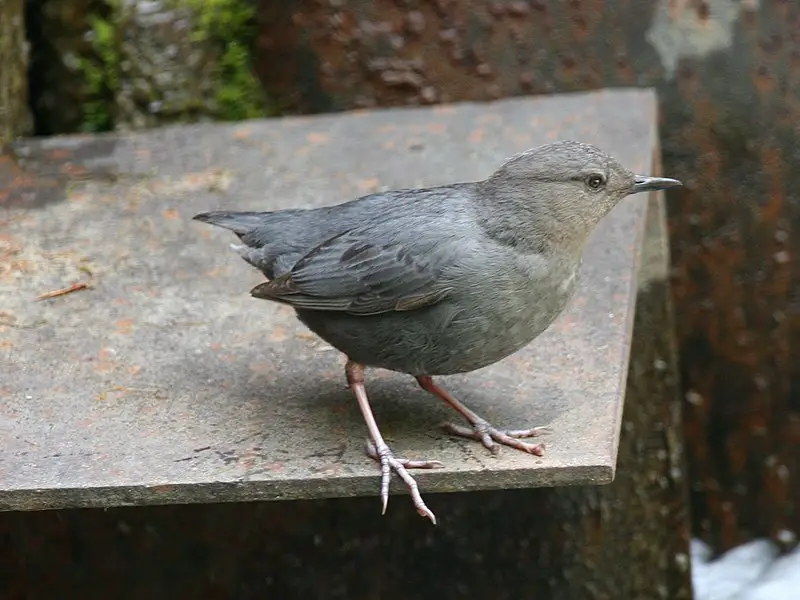
The American dipper is a small but stocky bird found in North America, with grey feathers and white eyelids that cause its eyes to appear to flash.
It measures approximately 16.5 cm (6.5 in) long and has a wingspan of 23 cm (9.1 in).
The average weight for an adult is 46 g (1.6 oz). This species can be identified by its habit of bobbing up and down when it pauses on rocks or logs near rivers or streams.
Hence the nickname ‘water ouzel’. Its diet consists mainly of aquatic insects which are collected from fast-flowing water using the strong claws located at the ends of their toes – amazing.
Scientific classification:
| Kingdom | Animalia |
| Phylum | Chordata |
| Class | Aves |
| Order | Passeriformes |
| Family | Cinclidae |
| Genus | Cinclus |
| Species | C. mexicanus |
Also Featured In: Most Popular Bird Species in North America, Birds in Pacific Northwest
6. Accipitridae
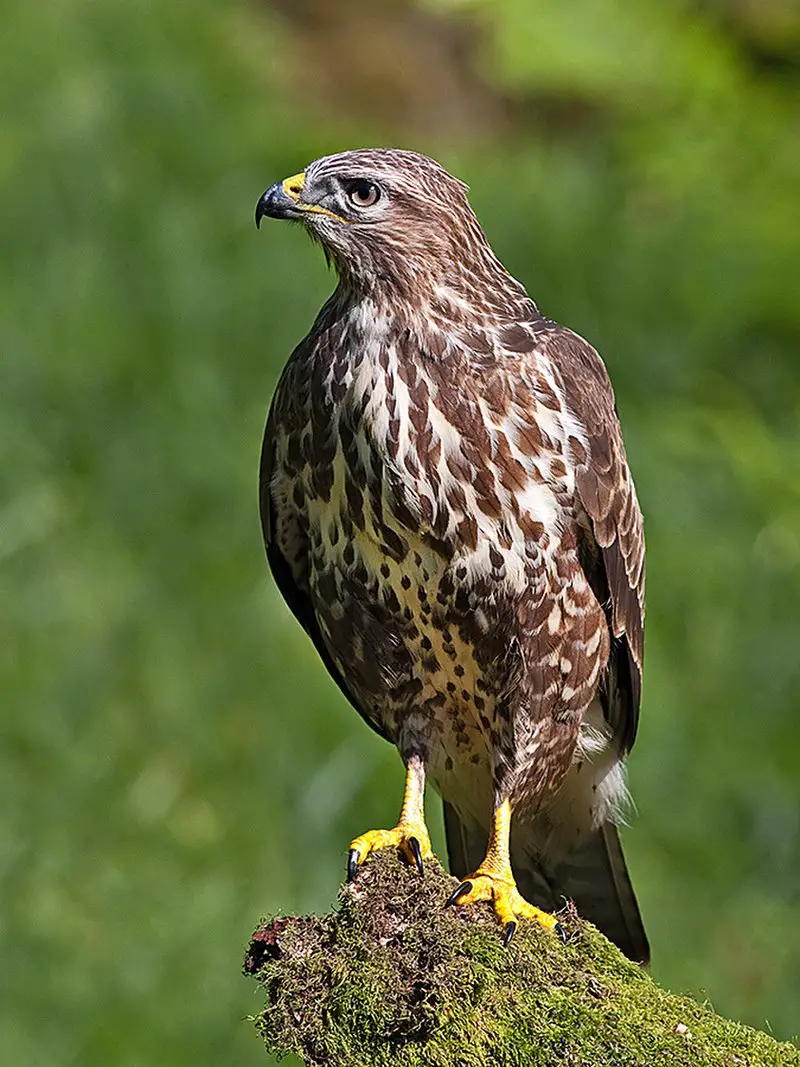
Accipitridae birds are a diverse family of raptors ranging in size from small to large. They have powerful hooked beaks which they use for hunting and tearing apart their prey, such as insects, medium-sized mammals and carrion.
Some species even feed on fruit. These birds can be found all over the world, making them an incredibly successful group of predators.
Accipitridae are adaptable hunters with keen eyesight that helps them spot potential meals from far away distances.
Their sharp talons assist them in grasping onto their victims while feeding or defending themselves against enemies.
Not only do these avian creatures provide us with visual beauty but also help keep our ecosystems healthy by keeping pest populations under control.
Scientific classification:
| Kingdom | Animalia |
| Phylum | Chordata |
| Class | Aves |
| Order | Accipitriformes |
| Family | Accipitridae Vieillot, 1816 |
Also Featured In: Most Common Types of Bangladeshi Birds, Italian Birds You Should Know
7. Long-Tailed Tit
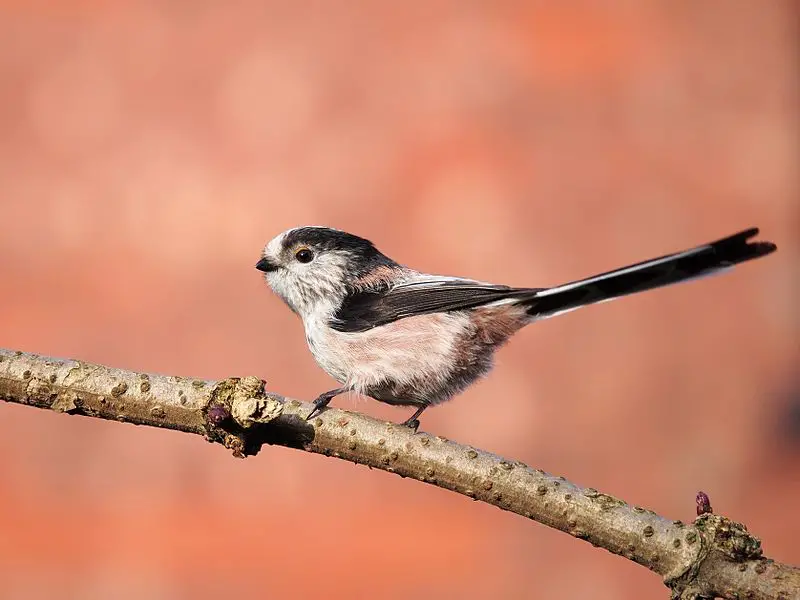
The Long-tailed tit is a common bird found throughout Europe and the Palearctic. Described by Carl Linnaeus in 1758, it has been given the scientific name Aegithalos caudatus which translates to “long tailed bush-tit”.
These birds are small with white bellies and grey backs. The distinguishing feature of this species is its long tail feathers which give them their name.
They feed on insects such as moths, flies and spiders but also eat seeds from plants like thistles or dandelions.
In cold weather they flock together for warmth while at night they roost inside woodpecker holes or other crevices in trees.
Long-tailed tits build intricately woven nests made of mosses, lichens, spider webs and fur held together by saliva – these can be up to 15 cm wide.
Scientific classification:
| Kingdom | Animalia |
| Phylum | Chordata |
| Class | Aves |
| Order | Passeriformes |
| Family | Aegithalidae |
| Genus | Aegithalos |
| Species | A. caudatus |
Also Featured In: Birds of United Kingdom, Ukrainian Birds You Should Know
8. Tit
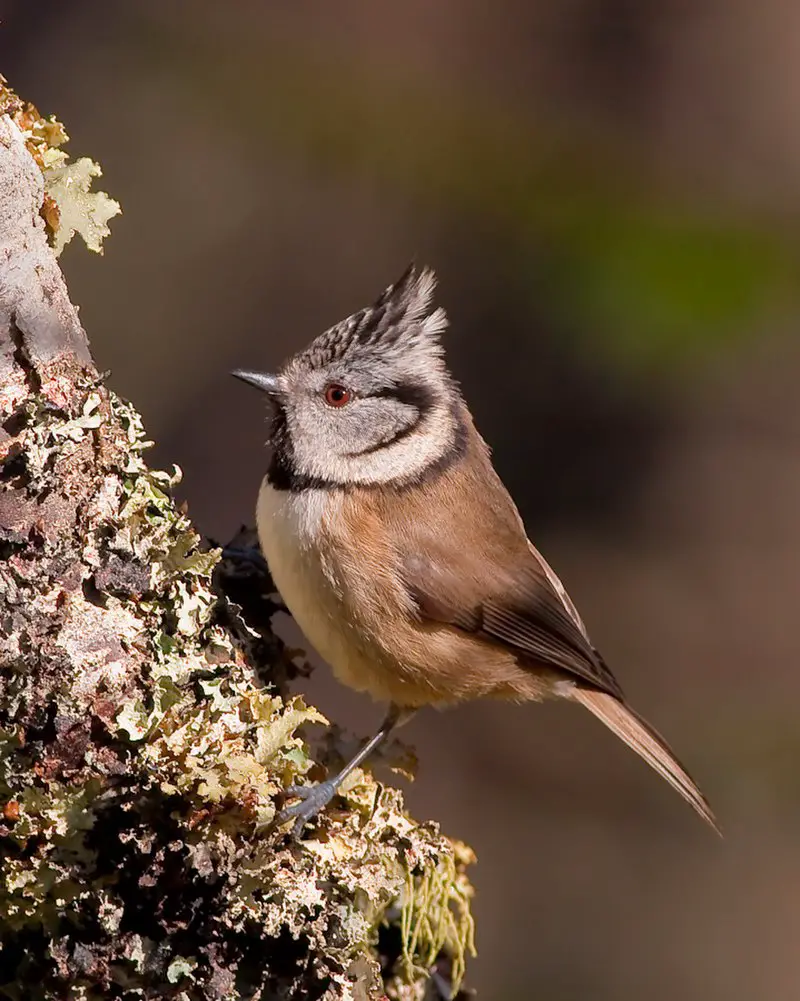
Tit birds are small passerine birds belonging to the family Paridae, found mainly in Northern Hemisphere and Africa.
These active little birds can be seen singing sweet songs throughout the day or scavenging for food at feeders.
They have short, stout bills which they use to crack open seeds and nuts with ease. Tit species range from chickadees to titmice; all of them sport a distinctive black head cap that stands out against their pale grey bodies.
Their bright eyes allow them excellent vision while searching for food – even on gloomy days when other predators may not see as well.
Tits are an important part of any healthy ecosystem and provide many ecological services such as insect control and seed dispersal.
Scientific classification:
| Kingdom | Animalia |
| Phylum | Chordata |
| Class | Aves |
| Order | Passeriformes |
| Infraorder | Passerida |
| Family | Paridae Vigors, 1825 |
Also Featured In: Willows Birds Around You, Turkey Birds You Should Know
9. Falcons And Caracaras
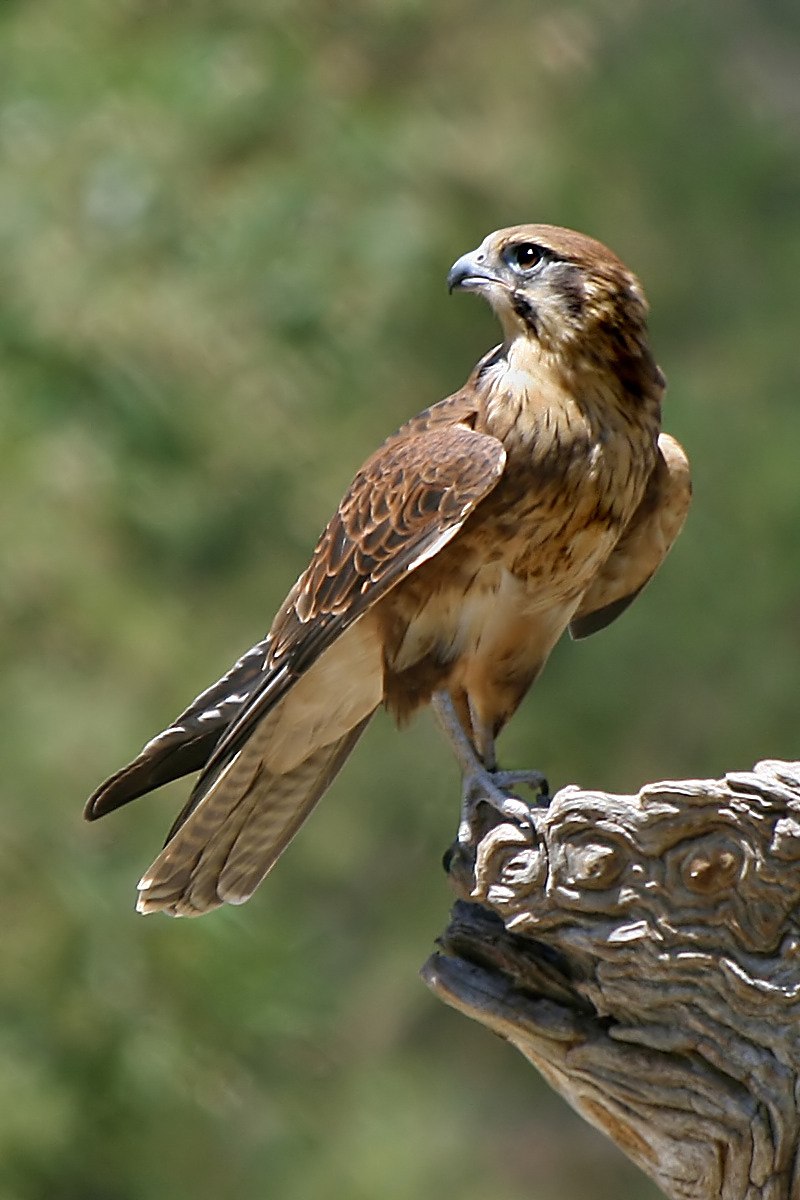
Falcons and caracaras are birds of prey that belong to the family Falconidae. They have impressive sharp talons, hooked beaks and keen eyesight which makes them excellent hunters.
Falcons can reach speeds up to 200 mph when diving for their prey while caracaras use a combination of running and flying to hunt small mammals such as rabbits or rats.
Both falcons and caracaras live in various areas around the world from grasslands, deserts, forests, wetlands or even urban areas where they nest on cliffs or tall buildings.
The diet mainly consists insects but also includes larger animals like reptiles or other birds which they catch by surprise with fast dives out of the sky.
Scientific classification:
| Kingdom | Animalia |
| Phylum | Chordata |
| Class | Aves |
| Order | Falconiformes |
| Family | Falconidae Leach, 1820 |
Also Featured In: Native South Korean Birds, Common Uzbekistan Birds
10. Tyrant Flycatchers
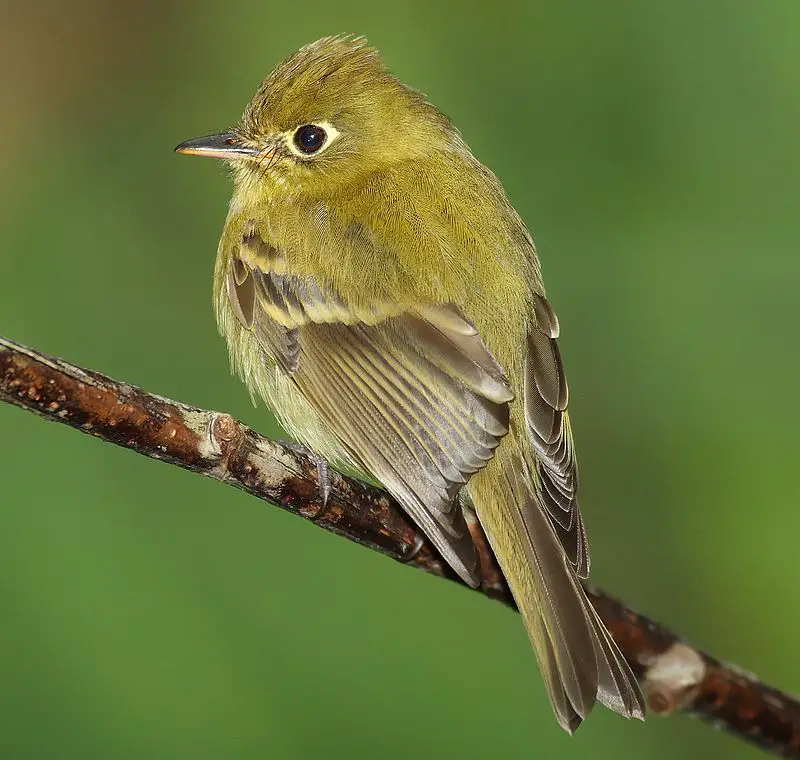
Tyrant flycatchers are a family of birds found in North and South America, containing over 400 species. These birds come in an array of shapes and sizes, with vibrant plumage to match.
They�re the most diverse avian family across all countries they inhabit except for the United States and Canada.
Their diet consists mainly of insects but also includes small reptiles or amphibians where available.
The behavior varies between each bird; some prefer open areas while others like dense forests as their habitat � many even migrate regularly.
Tyrant Flycatchers have adapted well to human presence thanks to the abundance of food sources that often accompany it � such as backyards, parks etc..
All things considered these incredible creatures are truly amazing.
Scientific classification:
| Kingdom | Animalia |
| Phylum | Chordata |
| Class | Aves |
| Order | Passeriformes |
| Parvorder | Tyrannida |
| Family | Tyrannidae Vigors, 1825 |
Also Featured In: Birds of Argentina, Birds that You’ll Find in Puerto Rico
11. Cardinal
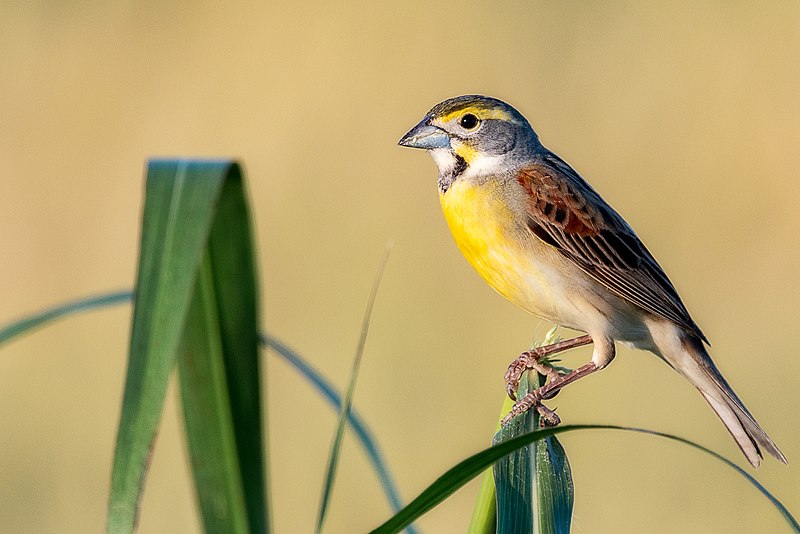
Cardinalidae is a family of passerine birds endemic to the New World that includes cardinals, grosbeaks and buntings.
This large group has great diversity in its members which range from tanager-like Piranga to warbler-like Granatellus.
They are usually distinguished by their bright plumage with reds, oranges and yellows being common among them.
Their strong bills enable them to feed on seeds, fruits and insects as well as other small prey items like lizards or frogs depending upon species.
Cardinals also have loud calls often used for territorial defense and courtship purposes while some can even imitate sounds made by other animals.
These adaptable birds inhabit a variety of habitats across North America making them an important part of many ecosystems there.
Scientific classification:
| Kingdom | Animalia |
| Phylum | Chordata |
| Class | Aves |
| Order | Passeriformes |
| Superfamily | Emberizoidea |
| Family | Cardinalidae Ridgway, 1901 |
Also Featured In: Common Birds in Canada, Famous Paintings Birds
12. Pine Grosbeak
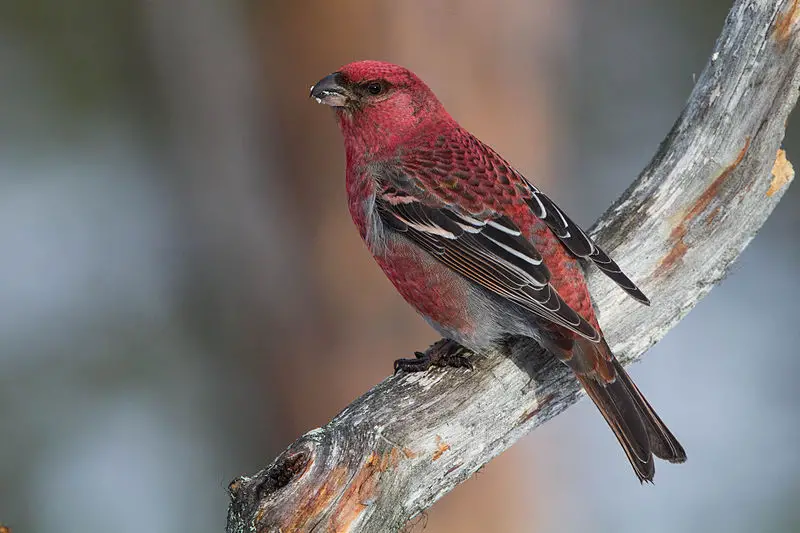
Pine grosbeak is a beautiful bird found across Alaska, western US, Canada and Fennoscandia to Siberia. It belongs to the family of true finch and it is the only species in its genus Pinicola.
This frugivorous bird has bright red feathers on its head and wings with yellowish white underparts that make it very attractive.
During winter season they feed mostly on small fruits like rowans, blueberries etc., while during summer months their diet consists mainly of insects.
They are shy birds but can be seen perched at high branches or singing from the topmost trees if you look carefully enough.
Scientific classification:
| Kingdom | Animalia |
| Phylum | Chordata |
| Class | Aves |
| Order | Passeriformes |
| Family | Fringillidae |
| Subfamily | Carduelinae |
| Genus | Pinicola Vieillot, 1808 |
| Species | P. enucleator |
Also Featured In: Birds of Nova Scotia, Spiritual Birds
13. Bicknell’s Thrush
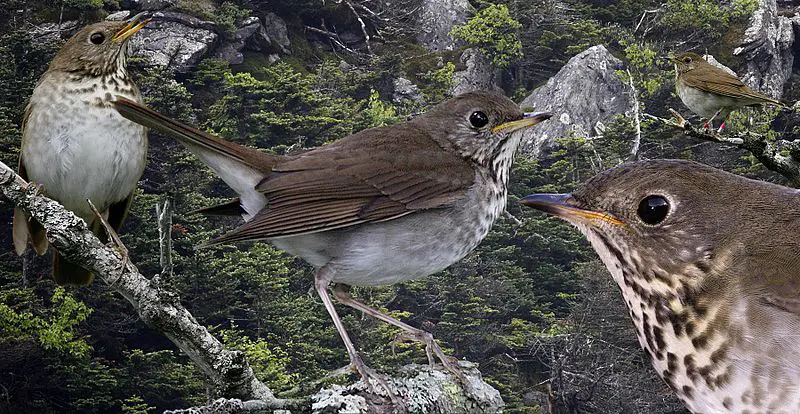
Bicknell’s thrush is a medium-sized bird native to North America, specifically the coniferous mountain tops and disturbed habitats of the Northeast. At 17.5 cm (6.9 in) long, it weighs 28 g (0.99 oz).
It closely resembles the gray-cheeked thrush but has quite different breeding grounds; this makes them two distinct species.
Bicknell’s thrushes feed on insects, fruits and berries that they find among leaf litter or low vegetation during summer months then migrate south for wintering season when food becomes scarce in their northern homes..
Despite its beauty and rarity, unfortunately Bicknell’s Thrush is listed as endangered because of habitat loss due to deforestation caused by human activities over time such as agriculture land conversion and urbanization.
Scientific classification:
| Kingdom | Animalia |
| Phylum | Chordata |
| Class | Aves |
| Order | Passeriformes |
| Family | Turdidae |
| Genus | Catharus |
| Species | C. bicknelli |
Also Featured In: British Virgin Islands Birds You Need to See,
14. Boreal Chickadee
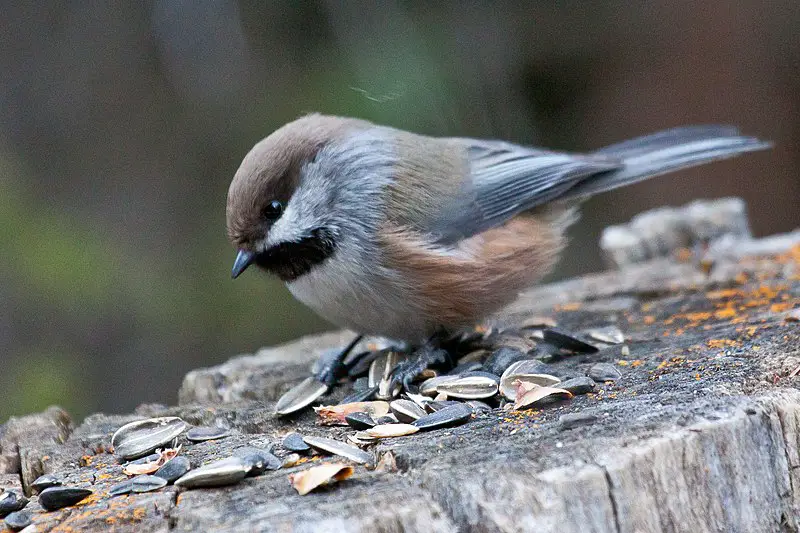
The Boreal Chickadee is a small, sparrow-like bird that inhabits the boreal forests of Canada and northern United States.
It has a distinct trill call that it uses to communicate with other birds in its area.
This species can be identified by its gray cap and bib, white cheeks, whitish underparts, black wings and tail feathers.
It also has yellow feet which helps distinguish it from similar looking birds like the Black-capped chickadee or the Carolina chickadee.
This species tends to remain within their range year round as they are nonmigratory birds due to their food storage habits during winter months when food sources become scarce.
They store food throughout trees using special techniques such as caching seeds into bark crevices or burying them underground for later retrieval when needed most.
Scientific classification:
| Kingdom | Animalia |
| Phylum | Chordata |
| Class | Aves |
| Order | Passeriformes |
| Family | Paridae |
| Genus | Poecile |
| Species | P. hudsonicus |
Also Featured In: Chickadees Birds, Common Birds in Saskatchewan
15. Mountain Chickadee
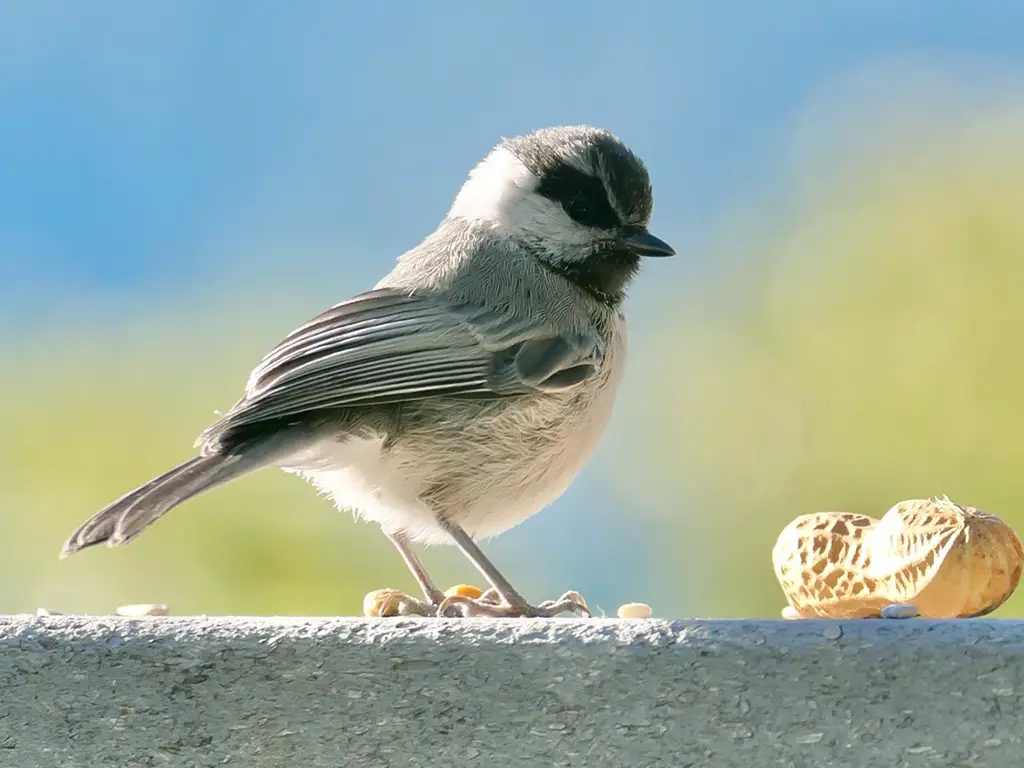
The Mountain Chickadee is a small songbird in the tit family Paridae. It’s distinct features include its black cap and bib, white cheeks, gray back and buffy underparts.
This bird was named after an American naturalist called William Gambel.
Recent studies have suggested that this species should be separated from other tits due to differences in their mitochondrial DNA cytochrome B sequence data as well as physical characteristics such as morphology.
They inhabit coniferous forests of North America between Alaska’s Aleutian Islands all the way down to northern Mexico.
The diet of these birds consist mainly on insects but they are also known to eat seeds and berries at times.
These active little birds often join mixed-species foraging flocks during wintertime with other chickadees, nuthatches or kinglets which helps them survive colder climates by pooling resources together when food sources become sparse.
Scientific classification:
| Kingdom | Animalia |
| Phylum | Chordata |
| Class | Aves |
| Order | Passeriformes |
| Family | Paridae |
| Genus | Poecile |
| Species | P. gambeli |
Also Featured In: Most Common Winter Birds, Birds That Live in Colorado
16. Brown Creeper
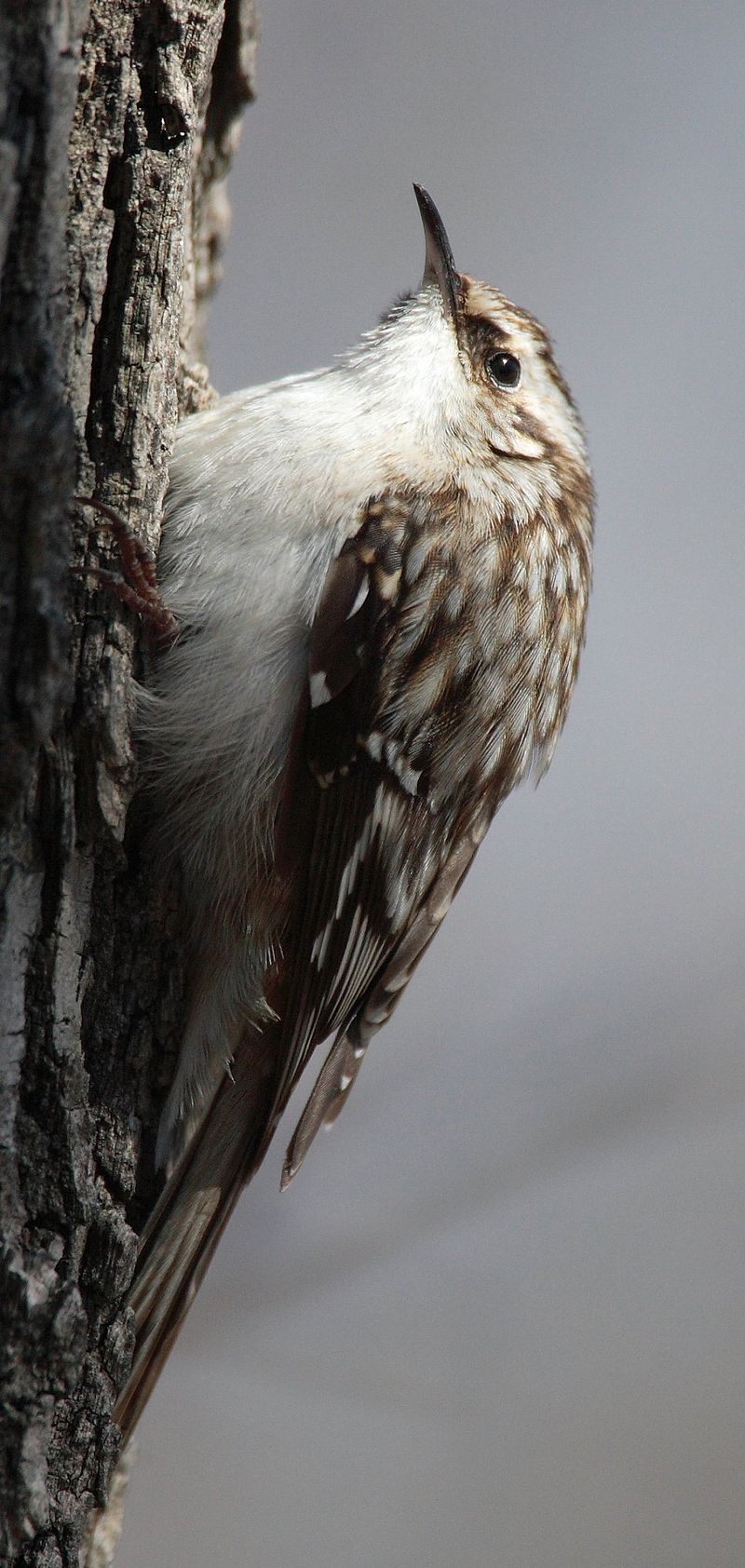
The Brown Creeper is a small songbird belonging to the Certhiidae family and is native to North America. It has brown upperparts with light spotting that resembles tree bark, as well as white underparts.
Its bill is long and thin with a slight downward curve while its tail is also long yet stiff; this helps it creep up trees.
This bird feeds mainly on insects which can be found in crevices of barks or dead plants, thanks to its curved bill which allows it access these hard-to-reach places.
When searching for food they move diagonally upwards around trunks so their camouflage blends in perfectly with the background making them difficult to spot.
Scientific classification:
| Kingdom | Animalia |
| Phylum | Chordata |
| Class | Aves |
| Order | Passeriformes |
| Family | Certhiidae |
| Genus | Certhia |
| Species | C. americana |
Also Featured In: New Hampshire Birds You Should Know, Birds in Iowa Spring
17. Red Crossbill
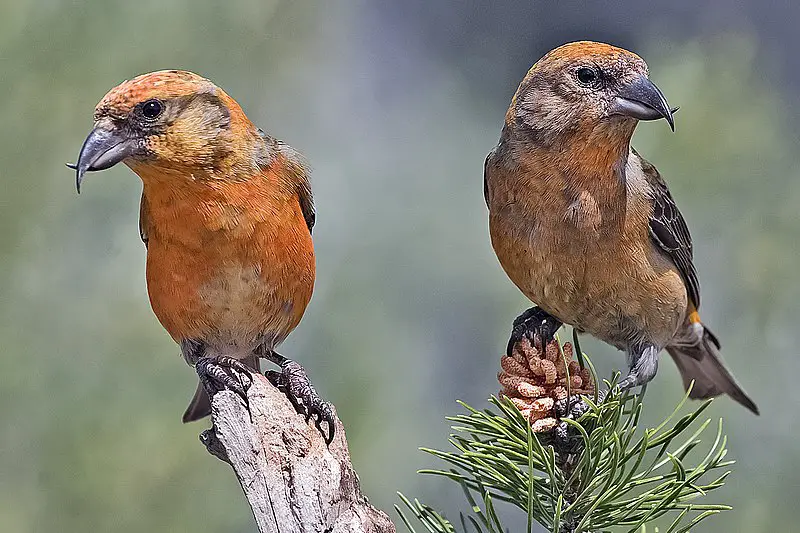
The Red Crossbill is a small passerine bird belonging to the finch family. It has distinctively crossed mandibles, which it uses to extract seeds from conifer cones and other fruits.
This species can be identified by its vivid colouring; males are red or orange in hue whilst females tend to have more green or yellow feathers.
Furthermore, there is considerable variation between individuals of this species when it comes to their beaks size and shape as well as their calls—which range from short trills through chirps and harsh cackles up until loud rattling sounds at times.
They’re an interesting sight in many parts of Europe, particularly during winter months where they often feed on pine cone seeds that drop down onto lower branches of trees.
Scientific classification:
| Kingdom | Animalia |
| Phylum | Chordata |
| Class | Aves |
| Order | Passeriformes |
| Family | Fringillidae |
| Subfamily | Carduelinae |
| Genus | Loxia |
| Species | L. curvirostra |
Also Featured In: Finches Species, Common Birds in Alberta
18. Pine Siskin
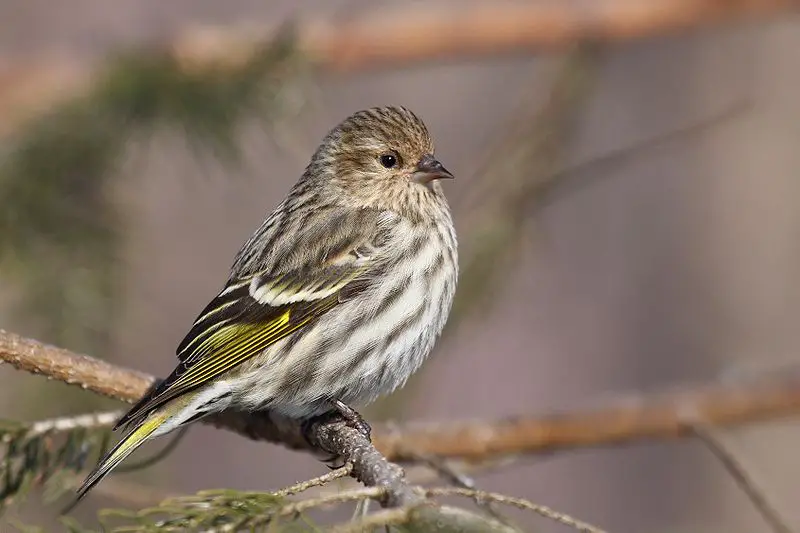
The Pine Siskin is a small bird from the finch family, primarily found in North America. It has an irregular migratory range and was first described by American ornithologist Alexander Wilson in 1810.
The species gets its name pinus, which means “pine-tree” in Latin, due to its frequent presence near coniferous trees.
Pine siskins are known for their yellow wing bars and streaked chests as well as their perky mannerisms when perched on branches or flying around looking for food during colder months.
They feed mostly on seeds of weeds, grasses and other plants but can also be seen consuming insects at times during summertime nesting season.
Its loud calls often alert nearby birds of potential danger while they nest high up among pine tree limbs where predators cannot reach them easily.
Scientific classification:
| Kingdom | Animalia |
| Phylum | Chordata |
| Class | Aves |
| Order | Passeriformes |
| Family | Fringillidae |
| Subfamily | Carduelinae |
| Genus | Spinus |
| Species | S. pinus |
Also Featured In: Autumn Birds You Should Know, Birds that Live in Mississippi
19. Yellow-Bellied Flycatcher
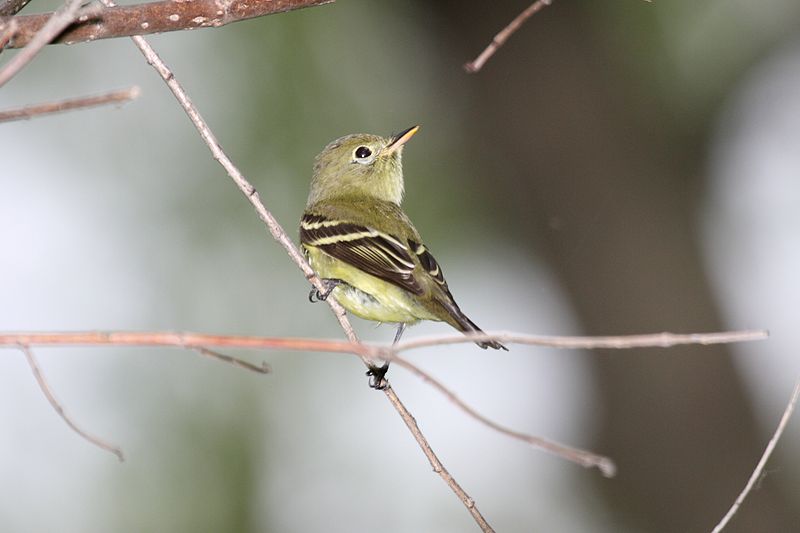
The Yellow-bellied Flycatcher is a small bird of the tyrant flycatcher family. It has greenish upperparts and yellowish underparts, with a dusky wash on its chest.
Its distinctive feature is the white or yellow eye ring that lacks any teardrop projection – setting it apart from other similar species in its family.
This insectivorous bird can be found in open habitats such as forest edges and woodland clearings across much of North America during summer months, when they migrate south to warmer areas for wintertime nesting.
They feed mainly on insects caught by sallying out after them from an exposed perch, but also take fruit occasionally at times of year when there are fewer flying insect prey available to eat.
Scientific classification:
| Kingdom | Animalia |
| Phylum | Chordata |
| Class | Aves |
| Order | Passeriformes |
| Family | Tyrannidae |
| Genus | Empidonax |
| Species | E. flaviventris |
Also Featured In: Flycatchers Species, Birds that Live in Newfoundland and Labrador
20. Swainson’s Thrush
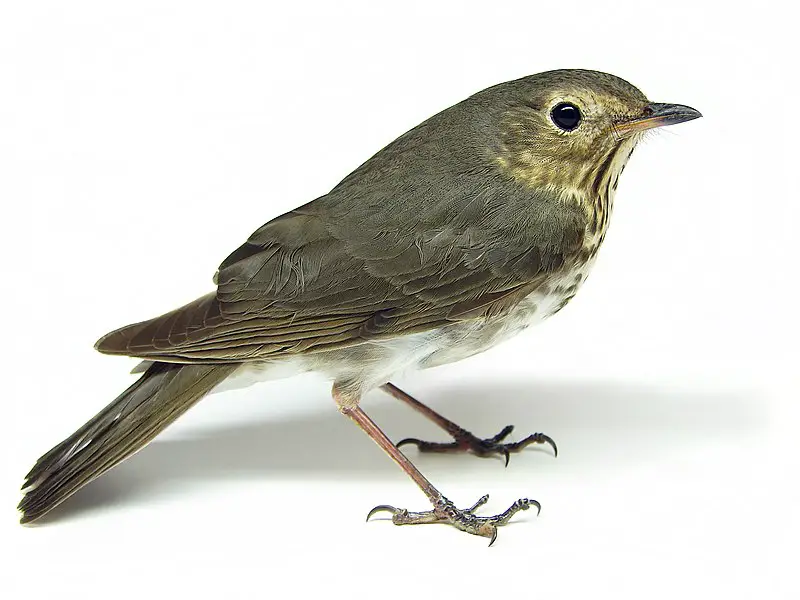
Swainson’s thrush is a medium-sized bird that belongs to the Catharus genus. Its coloration is subdued and its voice has been described as being flute-like, making it an appealing addition to any backyard.
It was named after William Swainson, an English ornithologist from the 19th century. The name of this species comes from Ancient Greek katharos which means “pure” or “clean” – appropriate for such a beautiful creature.
This type of thrush can be found throughout North America in habitats ranging from coniferous forests to open fields with scattered trees and shrubs; they also migrate south during winter months.
Despite their beauty, these birds are declining due to habitat loss and fragmentation so we must work together if we want them around forever.
Scientific classification:
| Kingdom | Animalia |
| Phylum | Chordata |
| Class | Aves |
| Order | Passeriformes |
| Family | Turdidae |
| Genus | Catharus |
| Species | C. ustulatus |
Also Featured In: Thrush Species, Common Birds in the Cities
21. Townsend’s Solitaire
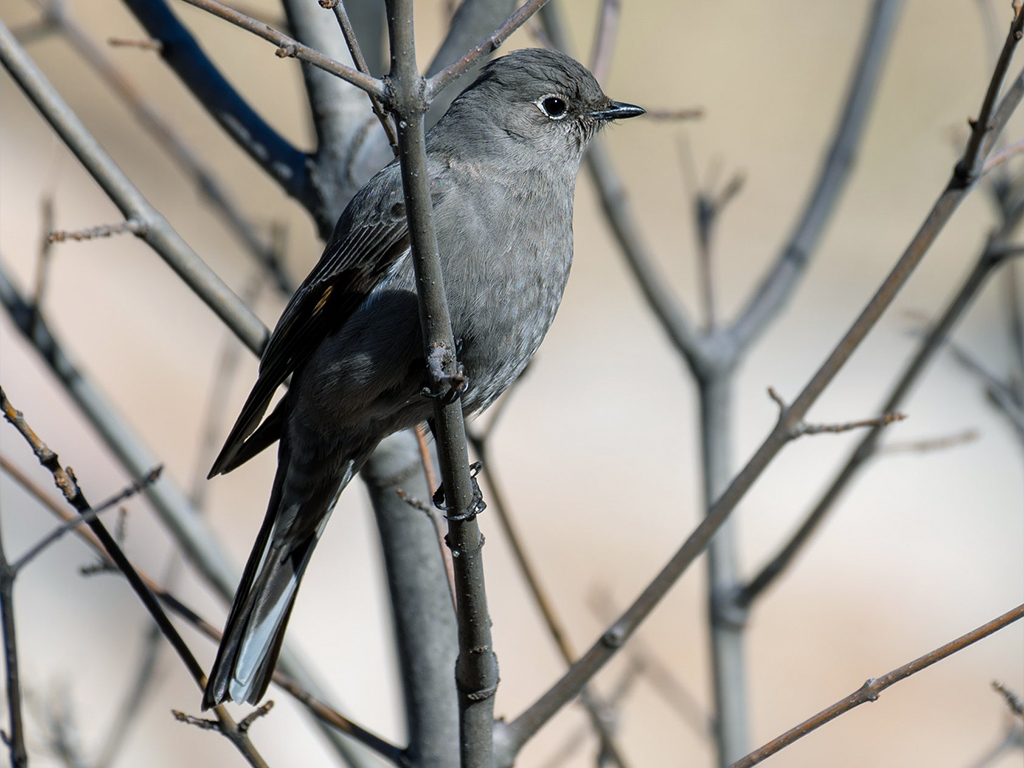
Townsend’s solitaire is a medium-sized thrush native to North America, ranging from Alaska and Canada all the way down to Zacatecas in Mexico.
It prefers montane woodlands but will travel for food during winter months – sometimes all the way down to Great Plains or desert oases.
This bird has distinct features such as grey upperparts with white spots on wings, buff underparts and light streaks on its head.
The Townsend’s Solitaire also makes an interesting sound – it produces melodic whistles which can be heard across long distances within forested areas.
Despite this birds beauty and song however, populations have been declining due largely to habitat destruction caused by logging activities.
Scientific classification:
| Kingdom | Animalia |
| Phylum | Chordata |
| Class | Aves |
| Order | Passeriformes |
| Family | Turdidae |
| Genus | Myadestes |
| Species | M. townsendi |
Also Featured In: Lake Tahoe Birds, Birds in Calgary You’ll Love to See
22. Winter Wren
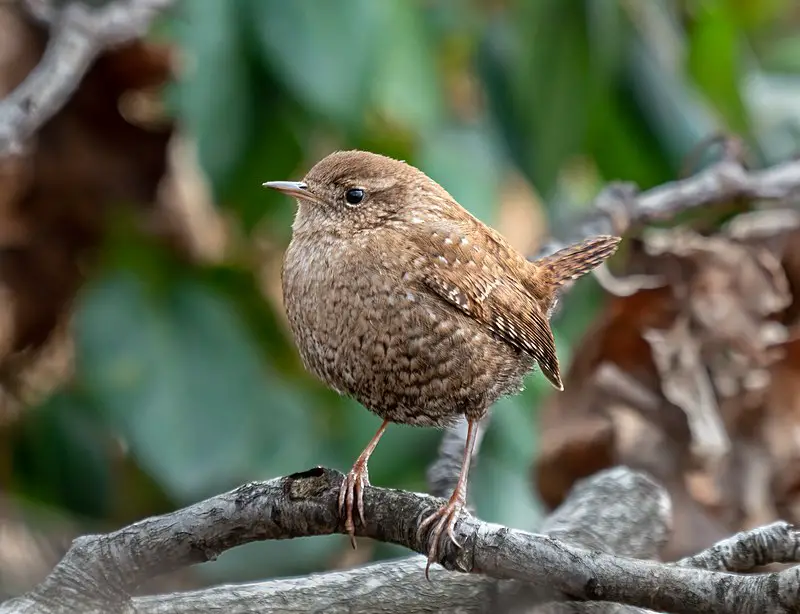
The Winter Wren is a tiny bird belonging to the New World wren family. It can be found in North America, from British Columbia all the way to the Atlantic Ocean.
In winter, it migrates south and sometimes even reaches Central America. Its habitat consists mainly of coniferous forests where it builds its nest on or near ground level within dense vegetation for protection against predators.
This small songbird has a rich brown plumage with white eyebrows and buff underparts which helps them blend into their environment perfectly.
The Winter Wrens are renowned for their loud songs that they sing both day and night during breeding season; making them an integral part of any forest ecosystem.
Scientific classification:
| Kingdom | Animalia |
| Phylum | Chordata |
| Class | Aves |
| Order | Passeriformes |
| Family | Troglodytidae |
| Genus | Troglodytes |
| Species | T. hiemalis |
Also Featured In: Wrens Species, North Carolina Mountain Birds
23. Blackpoll Warbler
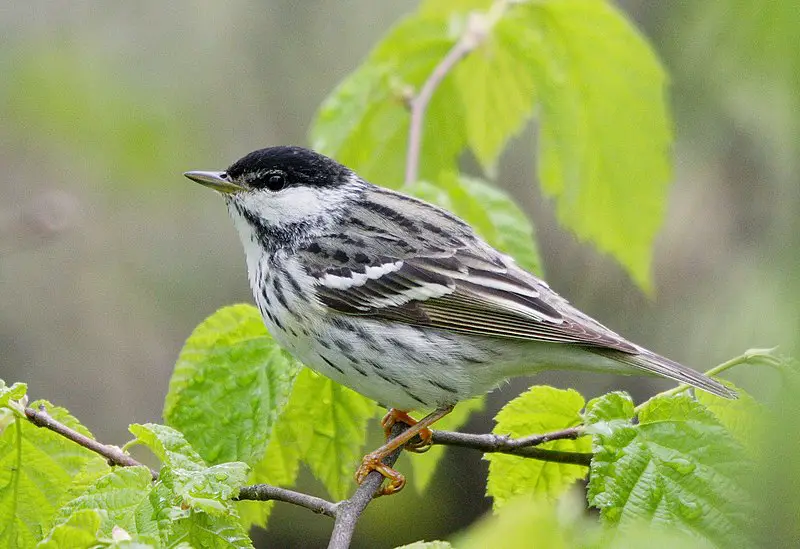
The Blackpoll Warbler is an impressive and beautiful bird. It has a black cap, white cheeks and white wing bars.
During the breeding season it can be found in forests of northern North America from Alaska through Canada to the mountains of New York and New England.
In fall they migrate south, sometimes travelling over 3,000 miles non-stop – one record was set for 75 hours.
They are very adaptable birds but their numbers have been declining due to habitat destruction so conservation efforts must remain ongoing if we want these amazing creatures around forevermore.
Scientific classification:
| Kingdom | Animalia |
| Phylum | Chordata |
| Class | Aves |
| Order | Passeriformes |
| Family | Parulidae |
| Genus | Setophaga |
| Species | S. striata |
Also Featured In: Pennsylvania Birds, Black And White Birds You Don’t Know About
24. White-Tailed Ptarmigan
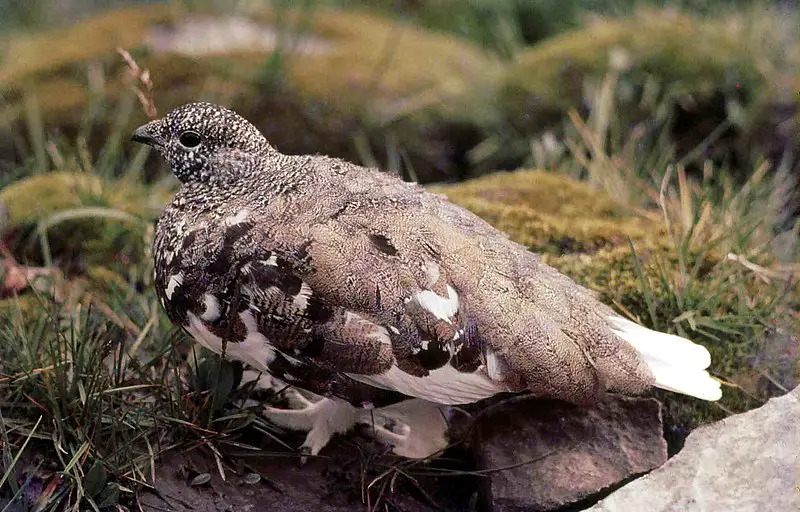
The white-tailed ptarmigan is a small, hardy bird found in high altitudes of Alaska, Canada and the western US. It belongs to the grouse family and has cryptic plumage that changes with each season.
In summer it sports grey, brown and white speckles while during winter its feathers become entirely white for camouflage against snow.
This adaption allows it to survive even at temperatures below freezing point.
Its diet consists mostly of plants such as willow buds or twigs but also includes insects like ants which provide additional nutrients when food sources are scarce during winter months.
An interesting behaviour trait is their tendency to walk away from predators instead of flying – they can fly but prefer not too.
Scientific classification:
| Kingdom | Animalia |
| Phylum | Chordata |
| Class | Aves |
| Order | Galliformes |
| Family | Phasianidae |
| Genus | Lagopus |
| Species | L. leucura |
Also Featured In: birds of Montana, British Columbian Birds
25. Clark’s Nutcracker
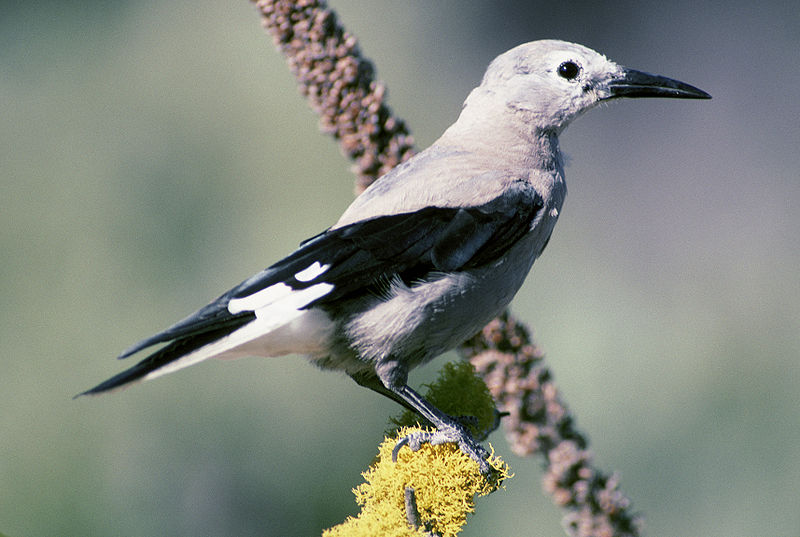
Clark’s nutcracker is a passerine bird in the Corvidae family, native to western North America. It has two alternate names: Clark’s crow and woodpecker crow.
Its primary food source are pine nuts which it stores for later retrieval by memory during winter months when other food sources may be scarce.
This omnivore also enjoys eating seeds, fruits and insects as part of its diet.
The species was first described by Lewis and Clark Expedition members in 1806 who noted that Native Americans used their feathers for ceremonial purposes due to their beauty.
They have distinctive black-and-white patterned wings with grey bodies sporting white underbellies.
They prefer open coniferous forests at higher altitudes where they can build nests on trees or cliffsides using twigs lined with soft materials such as grasses or mosses while taking advantage of natural cavities like stumps or hollows if available.
Scientific classification:
| Kingdom | Animalia |
| Phylum | Chordata |
| Class | Aves |
| Order | Passeriformes |
| Family | Corvidae |
| Genus | Nucifraga |
| Species | N. columbiana |
Also Featured In: birds of Wyoming, Birds that Live in Vancouver
26. Cinclidae
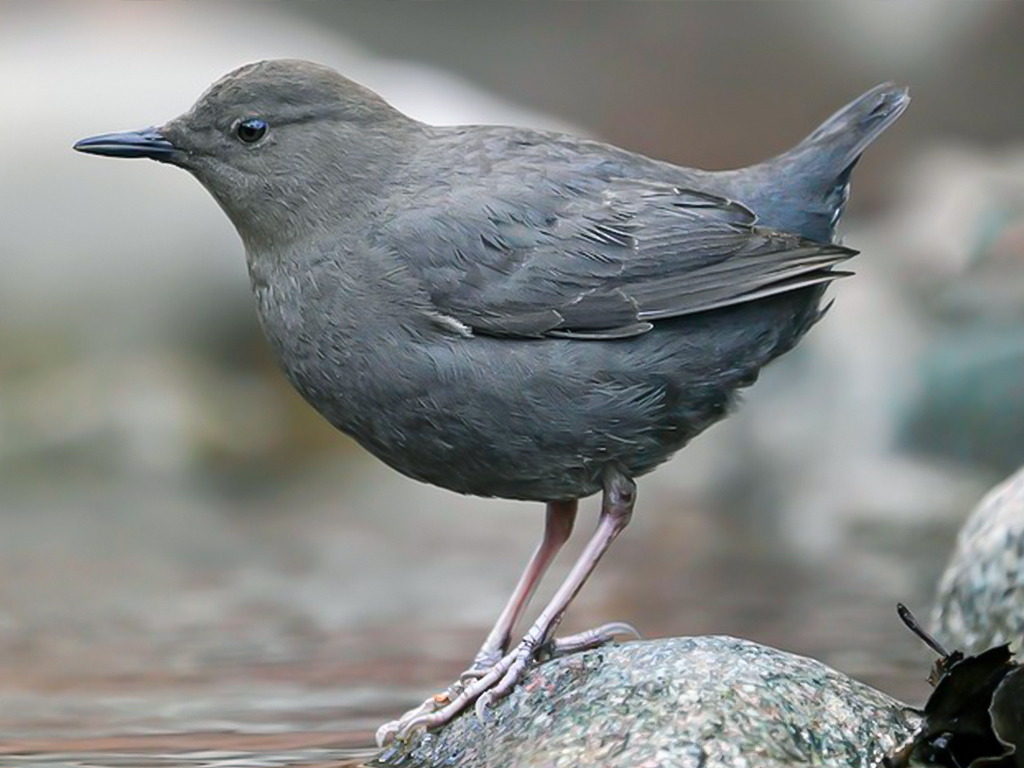
The Cinclidae bird family includes species known as dipper birds or water ouzels. These birds are known for their unique abilities to swim and dive underwater while searching for food, such as insects and small fish.
They have evolved features such as waterproof plumage, specialized feet, and strong wings to help them navigate through fast-moving streams and rapids.
Dippers are found in various habitats across North and South America, Europe, and Asia, and are recognized for their melodic songs that resonate across the rippling waters.
They are medium-sized birds with stout, compact bodies, short tails, and round heads. Their feathers are mostly dark gray or brown, with white underparts, and some species also have distinctive chestnut patches.
Despite their incredible aquatic skills, some dipper populations are declining due to habitat destruction and pollution.